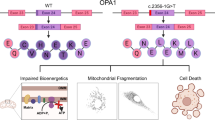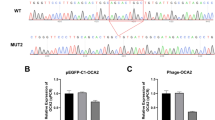Abstract
We report a 67-year-old Japanese woman with ataxia with oculomotor apraxia type 2 (AOA2). She was born to consanguineous parents and showed a teenage onset, a slowly progressive cerebellar ataxia and sensory-motor neuropathy and an elevated level of serum α-fetoprotein (AFP). All of these clinical features were consistent with typical AOA2. She lacked oculomotor apraxia, as frequently observed in previously reported AOA2 patients. She was homozygous for a novel nonsense mutation, Glu385Ter (E385X), in the senataxin gene (SETX). To our knowledge, this is the fifth Japanese family with genetically confirmed AOA2. The mutations in SETX in Japanese AOA2 families are heterogeneous, except for M274I, which has been found in two unrelated families. More extensive screening by serum AFP followed by molecular genetic analysis of SETX in patients with Friedreich’s ataxia-like phenotype may show that AOA2 is more common in Japan than previously thought.
Similar content being viewed by others
Log in or create a free account to read this content
Gain free access to this article, as well as selected content from this journal and more on nature.com
or
References
Moreira, M.- C. & Koenig, M. Ataxia with oculomotor apraxia type 2 in GeneReviews at GeneTests: Medical Genetics Information Resource [database online] Copyright, (University of Washington, Seattle, 1993–2008). Available at http://www.genetests.org; updated 5 March 2007.
Moreira, M.- C., Klur, S., Watanabe, M., Németh, A. H., Le Ber, I., Moniz, J.- C. et al. Senataxin, the ortholog of a yeast RNA helicase, is mutant in ataxia-ocular apraxia 2. Nat. Genet. 36, 225–227 (2004).
Suraweera, A., Becherel, O. J., Chen, P., Rundle, N., Woods, R., Nakamura, J. et al. Senataxin, defective in ataxia oculomotor apraxia type 2, is involved in the defense against oxidative DNA damage. J. Cell Biol. 177, 969–979 (2007).
Suraweera, A., Lim, Y., Woods, R., Birrell, G. W., Nasim, T., Becherel, O. J. et al. Functional role for senataxin, defective in ataxia oculomotor apraxia type 2, in transcriptional regulation. Hum. Mol. Genet. 18, 3384–3396 (2009).
Chen, Y. Z., Hashemi, S. H., Anderson, S. K., Huang, Y., Moreira, M.- C., Lynch, D. R. et al. Senataxin, the yeast Sen1p orthologue: characterization of a unique protein in which recessive mutations cause ataxia and dominant mutations cause motor neuron disease. Neurobiol. Dis. 23, 97–108 (2006).
Le Ber, I., Bouslam, N., Rivaud-Péchoux, S., Guimarães, J., Benomar, A., Chamayou, C. et al. Frequency and phenotypic spectrum of ataxia with oculomotor apraxia 2: a clinical and genetic study in 18 patients. Brain 127, 759–767 (2004).
Duquette, A., Roddier, K., McNabb-Baltar, J., Gosselin, I., St-Denis, A., Dicaire, M.- J. et al. Mutations in senataxin responsible for Quebec cluster of ataxia with neuropathy. Ann. Neurol. 57, 408–414 (2005).
Asaka, T., Yokoji, H., Ito, J., Yamaguchi, K. & Matsushima, A. Autosomal recessive ataxia with peripheral neuropathy and elevated AFP: novel mutations in SETX. Neurology 66, 1580–1581 (2006).
Criscuolo, C., Chessa, L., Di Giandomenico, S., Mancini, P., Saccà, F., Grieco, G. S. et al. Ataxia with oculomotor apraxia type 2: a clinical, pathologic, and genetic study. Neurology 66, 1207–1210 (2006).
Fogel, B. L. & Perlman, S. Novel mutations in the senataxin DNA/RNA helicase domain in ataxia with oculomotor apraxia 2. Neurology 67, 2083–2084 (2006).
Anheim, M., Fleury, M. C., Franques, J., Moreira, M.- C., Delaunoy, J. P., Stoppa-Lyonnet, D. et al. Clinical and molecular findings of ataxia with oculomotor apraxia type 2 in 4 families. Arch. Neurol. 65, 958–962 (2008).
Tazir, M., Ali-Pacha, L., M'Zahem, A., Delaunoy, J. P., Fritsch, M., Nouioua, S. et al. Ataxia with oculomotor apraxia type 2: a clinical and genetic study of 19 patients. J. Neurol. Sci. 278, 77–81 (2009).
Watanabe, M., Sugai, Y., Concannon, P., Koenig, M., Schmitt, M., Sato, M. et al. Familial spinocerebellar ataxia with cerebellar atrophy, peripheral neuropathy, and elevated level of serum creatine kinase, γ-globulin, and α-fetoprotein. Ann. Neurol. 44, 265–269 (1998).
Bomont, P., Watanabe, M., Gershoni-Barush, R., Shizuka, M., Tanaka, M., Sugano, J. et al. Homozygosity mapping of spinocerebellar ataxia with cerebellar atrophy and peripheral neuropathy to 9q33-34, and with hearing impairment and optic atrophy to 6p21-23. Eur. J. Hum. Genet. 8, 986–990 (2000).
Watanabe, M., Okamoto, K. & Shoji, M. Ataxia-ocular apraxia 2. Shinkei Kenkyu No Shinpo (Adv. Neurol. Sci.) 50, 371–377 (2006) (in Japanese).
Chen, Y.- Z., Bennett, C. L., Huynh, H. M., Blair, I. P., Puls, I., Irobi, J. et al. DNA/RNA helicase gene mutations in a form of juvenile amyotrophic lateral sclerosis (ALS4). Am. J. Hum. Genet. 74, 1128–1135 (2004).
Tsuji, S., Onodera, O., Goto, J. & Nishizawa, M. Sporadic ataxias in Japan—a population-based epidemiological study. Cerebellum 7, 189–197 (2008).
Acknowledgements
We thank Dr Hiroshi Takashima for kindly providing us with the information on his unpublished AOA2 family. This work was supported in part by a Grant-in-Aid for Science Research from the Ministry of Education, Science and Culture, Japan, and a grant from the Research Committee for Ataxic Diseases, the Ministry of Health, Labour, and Welfare, Japan.
Author information
Authors and Affiliations
Corresponding author
Rights and permissions
About this article
Cite this article
Nakamura, K., Yoshida, K., Makishita, H. et al. A novel nonsense mutation in a Japanese family with ataxia with oculomotor apraxia type 2 (AOA2). J Hum Genet 54, 746–748 (2009). https://doi.org/10.1038/jhg.2009.104
Received:
Revised:
Accepted:
Published:
Issue date:
DOI: https://doi.org/10.1038/jhg.2009.104



